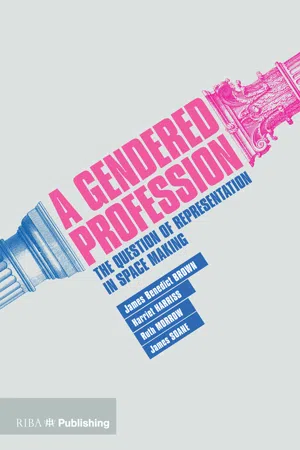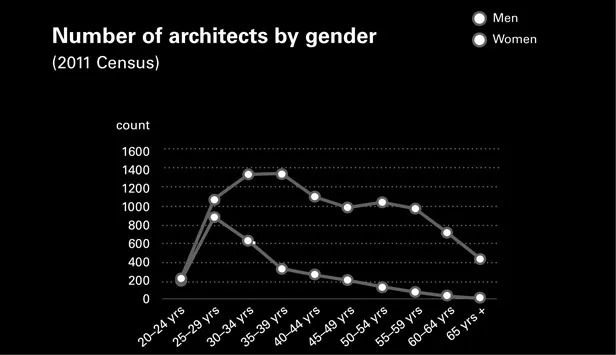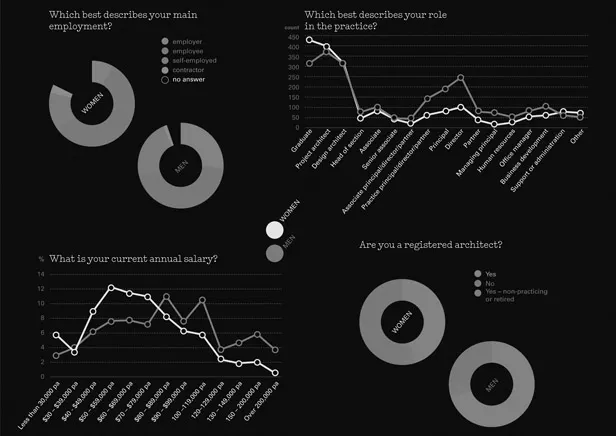
eBook - ePub
A Gendered Profession
This is a test
- 256 pages
- English
- ePUB (mobile friendly)
- Available on iOS & Android
eBook - ePub
A Gendered Profession
Book details
Book preview
Table of contents
Citations
About This Book
The issue of gender inequality in architecture has been part of the profession's discourse for many years, yet the continuing gender imbalance in architectural education and practice remains a difficult subject. This book seeks to change that. It provides the first ever attempt to move the debate about gender in architecture beyond the tradition of gender-segregated diagnostic or critical discourse on the debate towards something more propositional, actionable and transformative. To do this, A Gendered Profession brings together a comprehensive array of essays from a wide variety of experts in architectural education and practice, touching on issues such as LGBT, age, family status, and gender biased awards.
Frequently asked questions
At the moment all of our mobile-responsive ePub books are available to download via the app. Most of our PDFs are also available to download and we're working on making the final remaining ones downloadable now. Learn more here.
Both plans give you full access to the library and all of Perlego’s features. The only differences are the price and subscription period: With the annual plan you’ll save around 30% compared to 12 months on the monthly plan.
We are an online textbook subscription service, where you can get access to an entire online library for less than the price of a single book per month. With over 1 million books across 1000+ topics, we’ve got you covered! Learn more here.
Look out for the read-aloud symbol on your next book to see if you can listen to it. The read-aloud tool reads text aloud for you, highlighting the text as it is being read. You can pause it, speed it up and slow it down. Learn more here.
Yes, you can access A Gendered Profession by James Benedict Brown, Harriet Harriss, Ruth Morrow, James Soane, James Benedict Brown, Harriet Harriss, Ruth Morrow, James Soane in PDF and/or ePUB format, as well as other popular books in Architecture & Architecture General. We have over one million books available in our catalogue for you to explore.
Information
1
Practice Politics Economics
One
Six Myths about Women in Architecture
“Addressing the myths that impede women’s careers is essential to the viability and sustainability of the profession as a whole.”
Clichés abound about women in architecture, many of which are destructive and detrimental. Often based in perception and unacknowledged bias, they have become elusive yet powerful myths.
Myths are not based in evidence, or scholarly analysis. They are made over time, through the accumulation of many minor iterations – the off-the-cuff comments made when questions about gender are raised; the speculations about what happens to women in the profession; the entrenched assumptions about what it is to be an architect, about what an architect looks like and what an architect does.
Slippery, and persistent, these myths are difficult to challenge. Nevertheless, they constrict or skew many women’s careers in architecture. Challenging these myths is an important part of developing alternative stories and strategies for our profession.
The Research
Research undertaken as part of a three-year project investigating women in Australian architecture provides an opportunity to pin down these myths about women and architecture, and to shine some light on the assumptions contained within.
The project sought to map women’s participation in the profession and to understand why women are under represented, particularly at senior levels. It studied how gendered behaviour patterns are reproduced and reconfigured within specific work places. It identified actual and perceived barriers to women architects’ progression and located and promoted strategies for change.1
Two sets of material developed through this research are used in this essay. Gill Matthewson’s comprehensive statistical map of women’s participation in Australian architecture allows us to examine the myths in the light of statistical evidence, while the findings of two large-scale surveys – Where Do All the Women Go? (2012) and And What About the Men? (2012) – provide detailed qualitative accounts of careers in architecture that counter many clichés.2
The Myth of Architecture: ‘If you are Talented and Work Hard you will Succeed’
The myths considered here intersect with broader cultural assumptions about gender, women and work, and with other architectural mythologies: in particular, the idea that architecture is a meritocracy – which goes something like, ‘If you’re a really good designer you’ll succeed and be recognised and become famous and be showered with architectural commissions.’ This ideal underwrites much activity within schools of architecture, and drives many young practices and practitioners striving to make their mark.3
The problem with the myth of meritocracy is twofold. Firstly, it doesn’t prepare architects with the political and social skills they need to navigate a career. Secondly, it hides the structural issues that impact on everyone’s careers, for good or ill. This is important because inequity is experienced differently at different career moments. As Denise Scott Brown comments, ‘I say to young women today, don’t cast out your feminist awareness: when the glass ceiling hits you, you will think it is your fault, unless you know a bit about feminism, and it will destroy you.’4 But this is not just a matter for women – male survey respondents also express late career shock:
‘I am nearing the end of a career, which has stalled. The opportunity to evolve in large practices (or perhaps architecture?) feels limited at this point. I work in an ageist practice where the younger population is given considerable support and education enhancements. The older members of the practice are or appear to be ignored or excluded. My experience, and thus my knowledge, is valued, but tends to be used as blunt instrument for “difficult” projects. I have become a “fireman”, an exhausting role!’
Advantage and disadvantage are both cumulative. They build up over time via many small things. When advantage accumulates we may not recognise the structural circumstances: we are proud to be doing well and assume it is simply because we are talented, committed and hard working. In contrast, when things don’t go quite as we expect, many women (and some men) tend to blame themselves rather than considering what has happened in structural terms. Accumulating opportunity (or the lack of it) plays a significant part in the story of many women’s careers and impacts on their progression – as psychologist Virginia Valian argues, ‘Success is largely the accumulation of advantage, the parlaying of small gains into larger ones.’5
This is not to say that talent, commitment and hard work don’t matter. They do. But structural, social and cultural behaviour and expectations can promote and support some people’s talent and hard work while undermining and compromising others’. For example, a number of male survey respondents recognised that their success was a due to combination of hard work and the support of others:
‘I feel that I have had a magical run and that, having been given a leading role in a large practice early in my career, have proven to have been worthy of the confidence entrusted in me.’
‘I have been extremely fortunate in my career, having largely worked for excellent and talented architects that have trained me to be able to progress my career outside of my current employment and work at a level typically above the norm for my age.’
Succeeding as an architect requires the right alignment of social, cultural and political factors as well as talent and commitment, and the better we understand this, the more strategic we can be. It also requires support and trust from those who can help make opportunity.
Gender is not a Women’s Issue
Although our research explicitly addressed women in architecture, it is important to remember that ‘gender’ is not a synonym for ‘women’. Gender-based stereotypes also constrain men, and gender inequality and inequity are societal problems that need to be addressed collectively. We should also note that we are talking about women and men as groups. This can lead to generalisations that might not chime with an individual’s particular experience. But it is by looking at the experiences of groups that we identify structural factors. It is also important to have empathy and acknowledge a diversity of experiences.
Making things better for women will not make it worse for men. Indeed, as our survey responses make clear, many factors that work against women in architecture also impede many men, but they impact on women in exaggerated ways.
Six Myths about Women in Architecture
Myth 1: There is no Issue for Women in Architecture
Despite decades of work unequivocally demonstrating that women as a group experience multiple difficulties in charting architectural careers, the belief that there is no problem persists.6
‘I find it intriguing that you want to survey men and women architects separately. I have worked with or known many capable and recognised professional women (and non-professionals but highly competent). I don’t think they ever saw themselves as held back by a “glass ceiling”. They just made sure they did a damn good job with professional and competent commitment to their work, and the results and promotion in their careers came along … just like it does for men with the same expertise and commitment. And one must recognise the fact of life, that not everyone has the same abilities or commitment to their profession, probably for good reasons such as family, other interests, personal issues and maybe not being in the right place at the right time’.
Some, like the male respondent above, see careers only in terms of individual ability. Others recognise that women have different careers to men, but locate this in relation to broader social structures, and deny that aspects of architectural culture have any impact.
Many younger women see it all as a thing of the past – for them, ‘women in architecture’ is a cause mostly pursued by slightly batty older women. These young women have done well so far and see no reason why that won’t continue; the battles have already been fought, and they will reap the rewards. (I thought the same thing 25 years ago.)7
The blunt answer to this myth is that if a large number of women feel there is a problem then there is one. The many relieved responses after we launched the Parlour website attest to the presence of the problem – a tiny sample is below:
‘I was very pleased to see this forum appear. I have been wondering if other women in the profession were having similar issues, or if it was just me…’
‘It’s about time this discussion took centre stage. Opportunity, support and representation of women in architecture is, and has been abysmal for the 24 years since I started studying architecture at uni’.
‘Thank you for doing this work. It could alter the future of architecture, and that’s really exciting’.
‘I wish there was something like it when I graduated as I may have stayed longer in the industry’.
‘It is so important to have such third party voices out there. I sometimes feel like if I speak up about gender issues, it is perceived as either sour grapes, or an attempt to advantage myself personally’.
The statistics also bring the issue into sharp focus. Gill Matthewson’s visual summation of available statistics on participation in Australian architecture shows percentages of women in the profession via a number of measures. It succinctly demonstrates that, whatever measure used, women disappear as seniority increases.

Women in Australian architecture, 2012. Statistical analysis and data collection led by Gill Matthewson, with data visualisation by Georgina Russell and Catherine Griffiths
This is not simply a pipeline issue. Women have comprised approximately 40% of architectural graduates in Australia for at least two decades; the attrition of women students from architecture programmes is now on par with that of male students, and women are well represented, and active, as student and graduate members of the Australian Institute of Architects.8 However, following graduation women start disappearing from professional demographics: they lag significantly in registration statistics and are underrepresented in the Australian Institute of Architects membership categories available to registered architects.

Number of Australian architects by gender, 2011 Census
Data from the 2011 Australian census makes a similar point even more bluntly – the figure on the previous page shows proportions of men and women in the architectural profession according to age: note the major drop-off after the age of thirty.

Parlour surveys: Where Do All the Women Go? And What About the Men?
The data from our own surveys reinforces the point: a much higher proportion of women are employees rather than employers (8% of women were employers, compared to 26% of men); women were much less likely to be in senior positions, and are more likely to cluster in the lower salary ranges. Those who were directors or partners tended to be running small- to medium-sized practices. Men were more likely to have their current primary employment in private practice (78% of men and 50% of women) and to be a member of the Australian Institute of Architects (78% of men and 44% of women). Only half the female respondents are registered, compared to 70% of men, and many respondents – women and men – work rather more hours than they are paid for.9
All of this points to the reality that many women do experience a significant gap between educat...
Table of contents
- Cover
- Title
- Copyright
- CONTENTS
- CONTRIBUTOR BIOGRAPHIES
- EDITORIAL
- PART 1 PRACTICE, POLITICS AND ECONOMICS
- PART 2 HISTORIES, THEORIES AND PIONEERS
- PART 3 PLACE, PARTICIPATION AND IDENTITY
- PART 4 EDUCATION
- INDEX
- PICTURE CREDITS